Vermont is located in the northeast region of the United States. The state has cold, snowy winters and warm, humid summers, and it is part of the temperate broadleaf and mixed forests biome.
Vermont is home to various plant species, primarily covered by northern hardwoods and conifers, especially in the Green Mountains. While most of the state’s terrain is forested, some open areas are mainly used for agricultural purposes.
If you’re planning to visit Vermont, check out these native plants you may stumble upon on your trip!
1. Red Baneberry
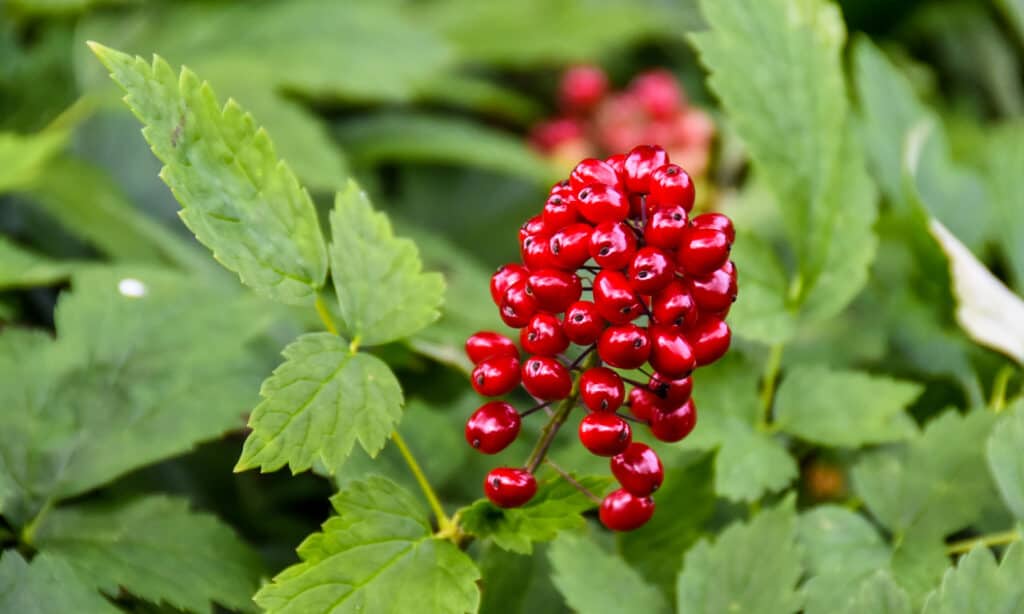
Red baneberry is a perennial plant growing up to 31 inches tall.
©HHelene/Shutterstock.com
| Red Baneberry | |
|---|---|
| Scientific name | Actaea rubra |
| Other common names | Chinaberry |
| Type of plant | Herbaceous flowering plant |
| Distribution | North America |
Red baneberry is a perennial plant growing up to 31 inches tall. The flowers are white and feature petals that are clawed at the base. Once the flowers wither, the plant produces green berries having an ellipsoid shape. These berries turn bright red in midsummer and feature a black dot.
The red baneberry plant is poisonous, and its berries are the most toxic. Red baneberry poisoning can occur from eating as few as six berries for adults and only two for children. It causes dizziness, increased pulse, nausea, and cardiac issues.
2. Downy Serviceberry
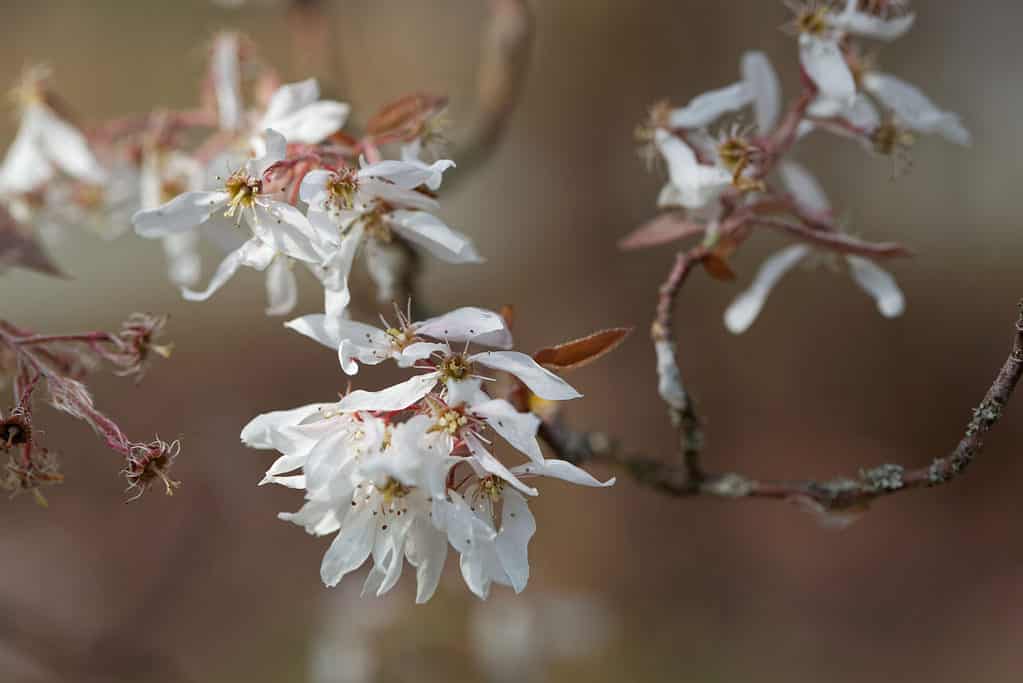
Downy serviceberry fruits are reddish-purple, have an apple-like shape, and ripen in summer.
©iStock.com/weisschr
| Downy Serviceberry | |
|---|---|
| Scientific name | Amelanchier arborea |
| Other common names | Common serviceberry, shadberry, juneberry |
| Type of plant | Shrub or small tree |
| Distribution | Eastern North America |
Downy serviceberry is a plant that can grow up to 66 feet tall and have a trunk diameter of around 6 inches. It has smooth, gray bark and slender buds with pointed tips.
Downy serviceberry leaves are elliptical or ovate and have finely serrated margins and pointed tips.
In early spring, the plant produces white flowers with five petals that grow on pendulous racemes and attract numerous bees for pollination. Downy serviceberry fruits are reddish-purple, have an apple-like shape, and ripen in summer. These fruits are a major food source for over 40 bird species!
3. Leatherleaf
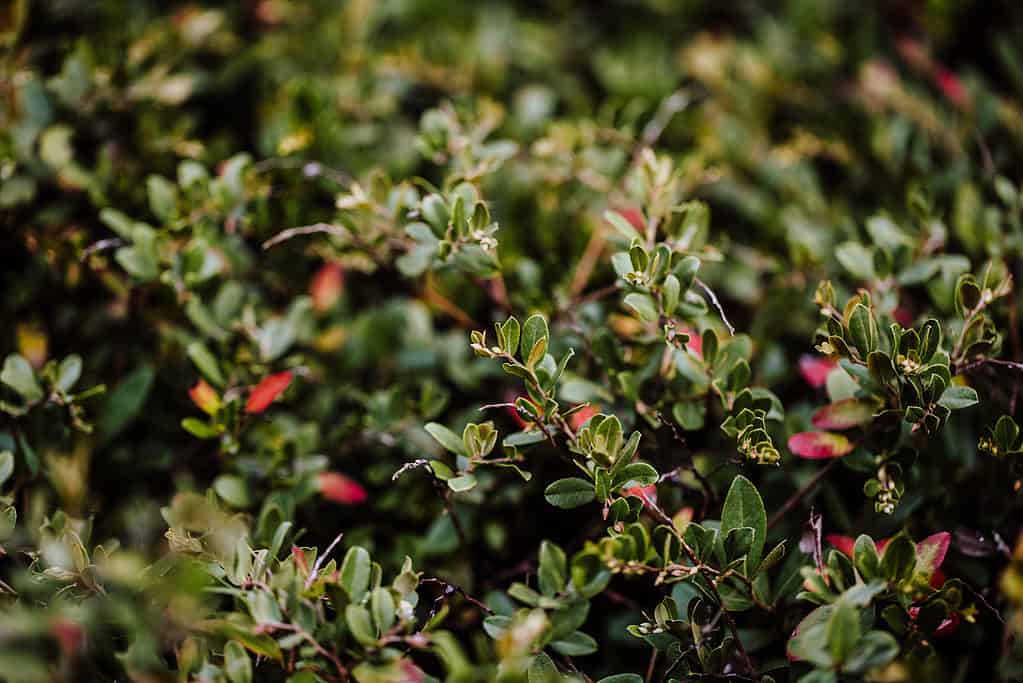
Leatherleaf shrubs produce small, white, bell-like flowers from April to June.
©iStock.com/LeaR
| Leatherleaf | |
|---|---|
| Scientific name | Chamaedaphne calyculata |
| Other common names | Cassandra |
| Type of plant | Perennial dwarf shrub |
| Distribution | North America, Europe, Asia |
Leatherleaf is a dwarf shrub that rarely grows taller than 4.9 feet. Its leathery, alternate, and elliptical to oblong leaves are dull green on top and pale green or brown on the underside. Even though leatherleaf is an evergreen plant, the leaves may turn red-brown when the temperatures drop. Leatherleaf shrubs produce small, white, bell-like flowers from April to June.
This dwarf shrub serves as a food source for the larvae of several Lepidoptera species. Moreover, it’s widely used in bouquets and other flower arrangements.
4. Dutchman’s Pipe
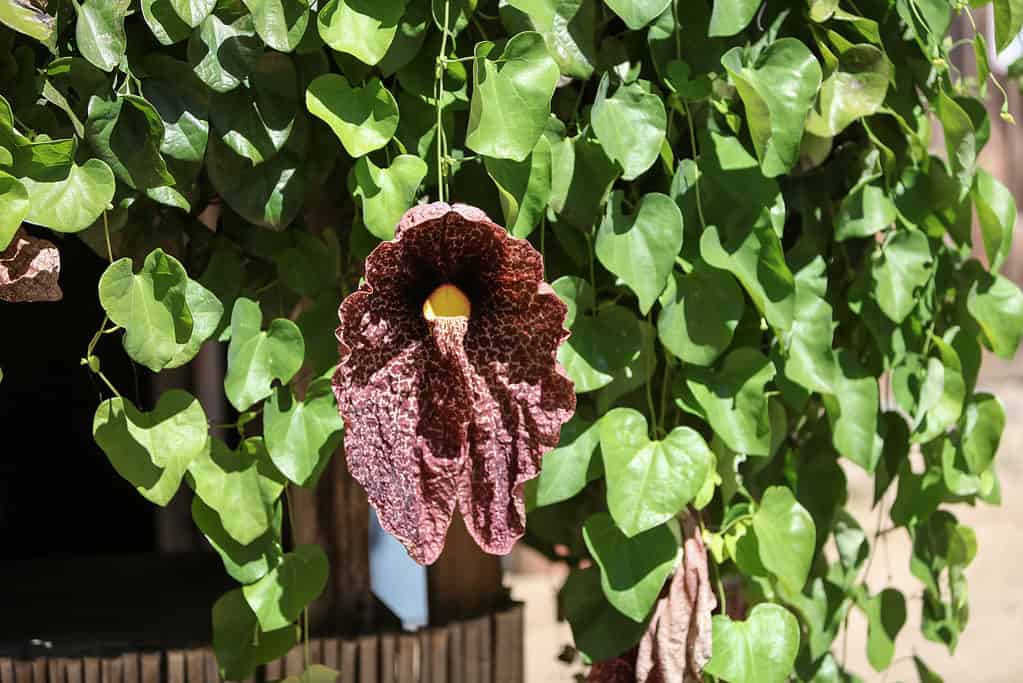
The Dutchman’s pipe features heart-shaped leaves measuring around 6 – 12 inches long.
©iStock.com/LagunaticPhoto
| Dutchman’s Pipe | |
|---|---|
| Scientific name | Artisolochia macrophylla |
| Other common names | Pipevine |
| Type of plant | Flowering vine |
| Distribution | Eastern United States, Canada |
The Dutchman’s pipe vine reaches sizes of up to 30 feet and features heart-shaped leaves measuring around 6 – 12 inches long. The plant blooms from June to August, producing yellowish-green flowers that attract flies and gnats. The insects are trapped inside a flower tube, thus being forced to carry out pollination.
This vine grows well in medium loamy soils, sandy soils, and clay soils. However, it thrives best in drained soils with high pH levels.
5. Red Maple

Young red maple trees have smooth, pale gray bark, while adult specimens have cracked, dark bark.
©iStock.com/JUN DONG
| Red Maple | |
|---|---|
| Scientific name | Acer rubrum |
| Other common names | Swamp maple, soft maple, water maple |
| Type of plant | Deciduous tree |
| Distribution | North America |
The red maple tree is a common deciduous tree in North America that usually grows up to 100 feet tall. However, the tree can reach exceptional heights of over 135 feet in its natural habitat!
Young maple trees have smooth, pale gray bark, while adult specimens have cracked, dark bark. They feature oppositely arranged leaves with serrated margins. The leaf’s upper side is light green, and the underside has a white shade, while the leaf stalks are red. In autumn, the leaves get a brilliant red color, sometimes yellow or orange, which provides the trees with outstanding beauty!
From winter to spring, red maple trees produce red flowers with five small petals.
6. Yellow Birch
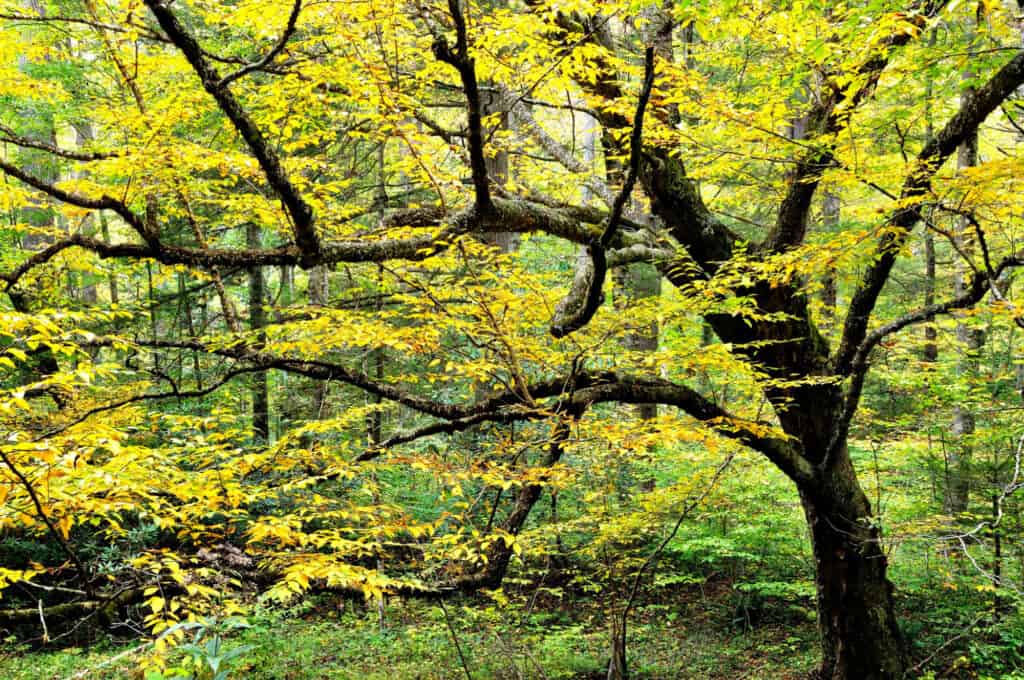
Yellow birch is a medium-sized deciduous tree that grows up to 80 feet tall.
©Malachi Jacobs/Shutterstock.com
| Yellow Birch | |
|---|---|
| Scientific name | Betula alleghaniensis |
| Other common names | Golden birch, swamp birch |
| Type of plant | Deciduous tree |
| Distribution | Northeastern North America |
Yellow birch is a medium-sized deciduous tree that grows up to 80 feet tall, sometimes reaching as much as 100 feet. Its trunk makes it the largest birch species in North America, measuring around 2 – 3 feet in diameter. Moreover, it’s a long-living tree, often living up to 300 years.
Its name comes from its yellow-bronze bark, which often has dark horizontal lenticels (porous tissues) and small black marks. The heart-shaped leaves are alternately arranged on the stem and have a pointed tip and a finely serrated margin.
In late spring, yellow birch produces male and female catkins on the same tree – the female flowers point upward, while male catkins hand downwards.
7. Shagbark Hickory

The shagbark hickory is a tall deciduous tree reaching over 100 feet.
©iStock.com/Ethan R.
| Shagbark Hickory | |
|---|---|
| Scientific name | Carya ovata |
| Type of plant | Deciduous tree |
| Distribution | Eastern United States |
The shagbark hickory is a tall deciduous tree reaching heights of over 100 feet and living for more than 350 years. It has pinnate leaves measuring 12 – 24 inches long, each with five leaflets.
The shagbark hickory is monoecious, producing male and female flowers on the same tree. Moreover, it produces edible nuts, a major food source for raccoons, mice, chipmunks, and gray and red squirrels.
Shagbark hickory trees are common throughout the eastern United States but are found only in Vermont’s southwestern and southeastern regions.
8. Yellow Giant Hyssop
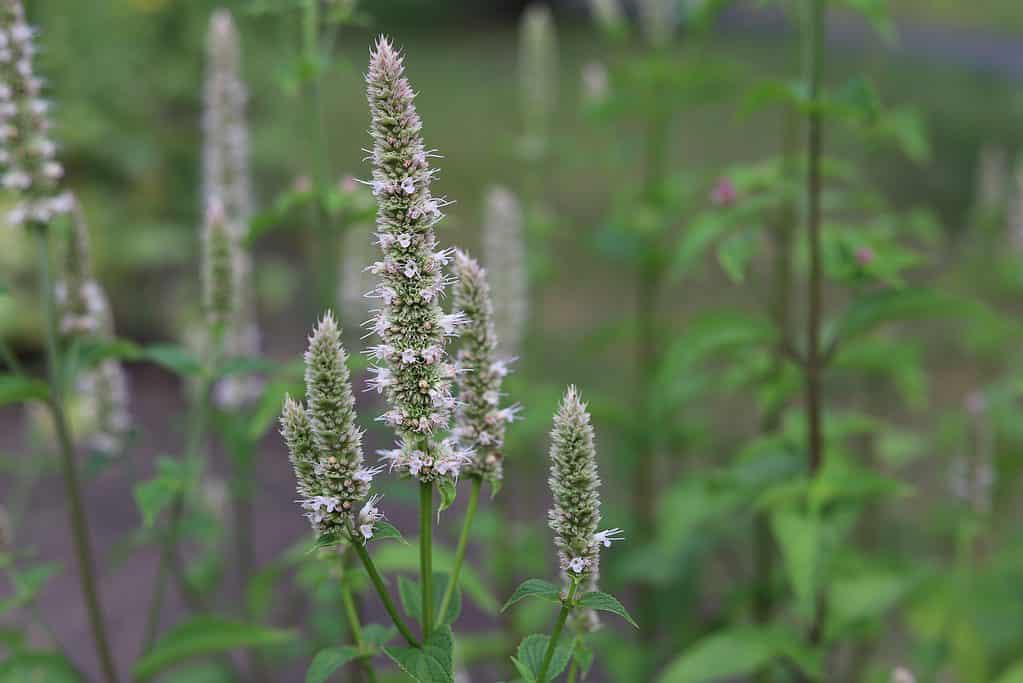
The yellow giant hyssop primarily grows in meadows, upland deciduous woods, and lowland woods.
©Kabar/Shutterstock.com
| Yellow Giant Hyssop | |
|---|---|
| Scientific name | Agastache nepetoides |
| Type of plant | Herbaceous perennial plant |
| Distribution | Central and Eastern United States, Canada |
The yellow giant hyssop is a member of the mint family that grows up to 7 feet tall. It has a hairless, erect stem and a few branches. Unlike the leaves of other members of the mint family, yellow giant hyssop leaves do not have a scent. They measure 2 – 6 inches long and 1 – 3 inches wide and are thin and ovate or ovate-lanceolate.
In late summer, this plant produces greenish-yellow flowers that bloom individually at the end of the central and major secondary stems. Flower spikes are 4 – 16 inches long and are a major attraction for bees.
The yellow giant hyssop primarily grows in meadows, upland deciduous woods, and lowland woods. In Vermont, it’s currently listed as Endangered.
9. Purple Joe-Pye Weed
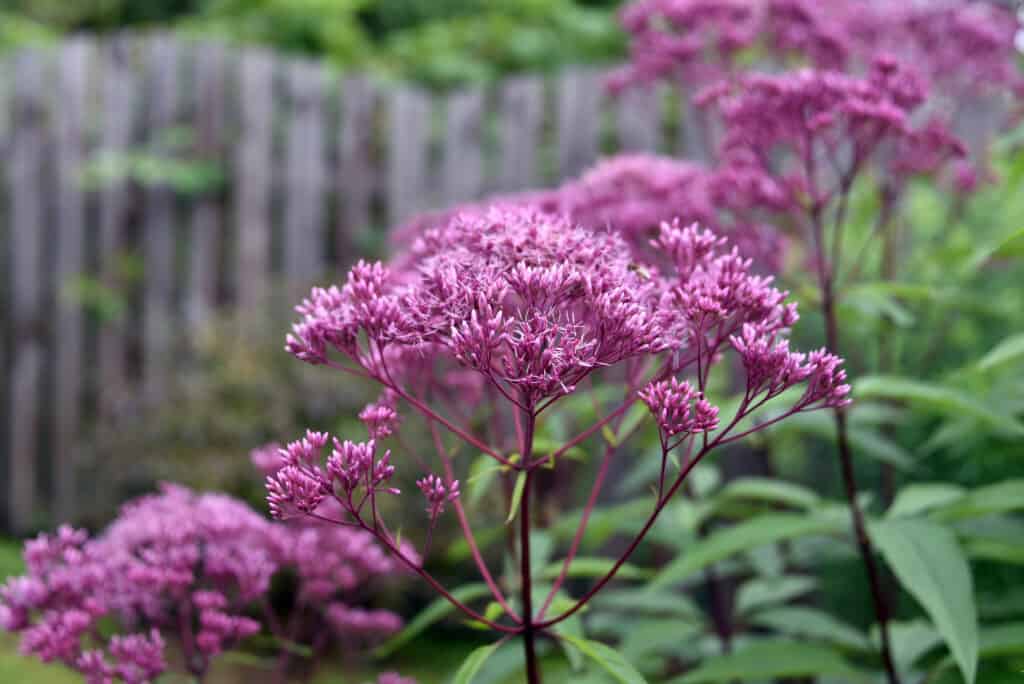
The purple Joe-Pye weed can reach 7.9 feet tall and 3.9 feet wide.
©Andrey_Nikitin/Shutterstock.com
| Purple Joe-Pye weed | |
|---|---|
| Scientific name | Eutrochium purpureum |
| Other common names | Sweetscented joe pye weed |
| Type of plant | Herbaceous perennial plant |
| Distribution | Eastern and central North America |
The purple Joe-Pye weed is a clump-forming herb native to eastern and central North America, Vermont included. This herbaceous plant can reach 7.9 feet tall and 3.9 feet wide and thrives best in full sun to part shade.
Its stems are erect and thick, featuring a purplish shade. The leaves grow in whorls at each stem node. Once the purplish flowers bloom (in mid to late summer), the stems bend downward. At that time, the Eutrochium purpureum attracts moths, bees, flies, and butterflies that feed on the flower nectar. Moreover, this herb is a larval host for four types of moths:
- the eupatorium borer moth
- the three-lined flower moth
- the ruby tiger moth
- the red groundling moth.
10. White Snakeroot

White snakeroot plants grow up to 4.9 feet tall.
©Nahhana/Shutterstock.com
| White Snakeroot | |
|---|---|
| Scientific name | Ageratina altissima |
| Other common names | Richweed, white sanicle |
| Type of plant | Perennial herb |
| Distribution | Eastern and central North America |
White snakeroot plants grow up to 4.9 feet tall. They have smooth stems with oppositely arranged 6-inch-long leaves with sharply serrated margins. The plant produces white flowers, which release small seeds in the wind after blooming. White snakeroot herbs are highly adaptable, growing in both thick woods and slightly shaded open areas.
The white snakeroot contains the tremetol toxin, which contaminates the meat and milk of cattle if the animals consume it. Afterward, it’s spread to humans, causing tremetol poisoning if large quantities are ingested. Moreover, studies show that white snakeroot is toxic for most animals and causes muscle weakness and trembling if ingested.
Up Next:
- The 12 Biggest Lakes in Vermont
- The 5 Best Places to Camp in Vermont this Summer
- 9 Native Plants in South Dakota
The photo featured at the top of this post is © ForestSeasons/Shutterstock.com
Sources
- Gardenia, Available here: https://www.gardenia.net/native-plants/vermont
- Audubon Vermont, Available here: https://vt.audubon.org/plants-birds/superstar-native-plants-vermont
- CABI, Available here: https://www.cabdirect.org/cabdirect/abstract/19422200685
Thank you for reading! Have some feedback for us? Contact the AZ Animals editorial team.






